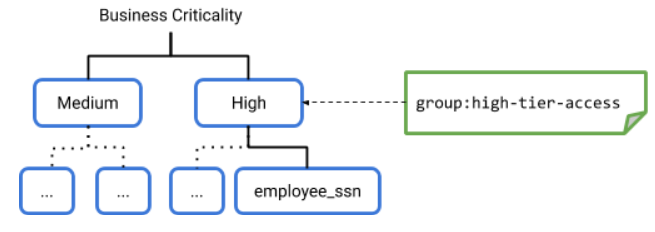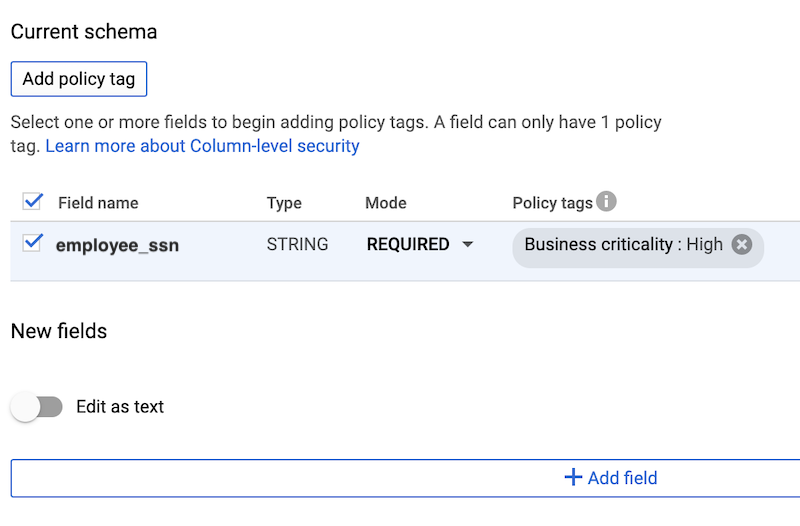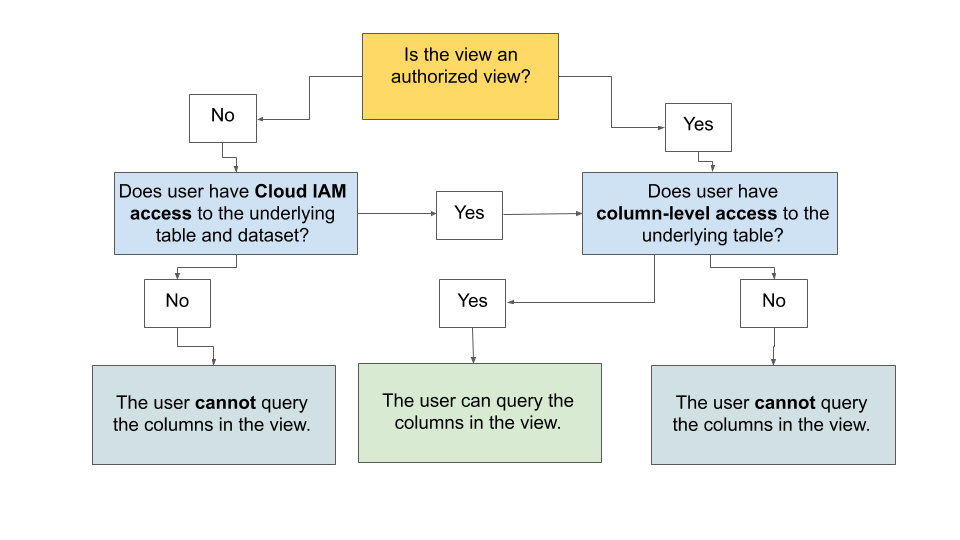Introduction to column-level access control
BigQuery provides fine-grained access to sensitive columns using policy tags, or type-based classification, of data. Using BigQuery column-level access control, you can create policies that check, at query time, whether a user has proper access. For example, a policy can enforce access checks such as:
- You must be in
group:high-accessto see the columns containingTYPE_SSN.
To enhance column-level access control, you can optionally use dynamic data masking. Data masking lets you mask sensitive data by substituting null, default, or hashed content in place of the column's actual value.
Column-level access control workflow

To restrict data access at the column level:
Define a taxonomy and policy tags. Create and manage a taxonomy and policy tags for your data. For guidelines, see Best practices for policy tags.
Assign policy tags to your BigQuery columns. In BigQuery, use schema annotations to assign a policy tag to each column where you want to restrict access.
Enforce access control on the taxonomy. Enforcing access control causes the access restrictions defined for all of the policy tags in the taxonomy to be applied.
Manage access on the policy tags. Use Identity and Access Management (IAM) policies to restrict access to each policy tag. The policy is in effect for each column that belongs to the policy tag.
When a user tries to access column data at query time, BigQuery checks the column policy tag and its policy to see whether the user is authorized to access the data.
Identify what needs to be tagged
To determine the types of sensitive data that you have and which columns need policy tags, consider generating profiles about your data across an organization, folder, or project using Sensitive Data Protection. Data profiles contain metrics and metadata about your tables and help you determine where sensitive and high-risk data reside. Sensitive Data Protection reports these metrics at the project, table, and column levels. For more information, see Data profiles for BigQuery data.
The following image shows a list of column data profiles (click to enlarge). Columns with high data-risk values might contain high-sensitivity data and have no column-level access controls. Alternatively, those columns might contain moderate or high-sensitivity data that is accessible to a large number of people.

Example use case
Consider an organization that needs to classify sensitive data into two categories: High and Medium.

To set up column level security, a data steward, who has the appropriate permissions, would perform the following steps to set up a hierarchy of data classification.
The data steward creates a taxonomy named "Business criticality". The taxonomy includes the nodes, or policy tags High and Medium.
The data steward decides that the policy for the High node includes access for a group named high-tier-access.
The data steward creates more levels of nodes in the taxonomy, under High and Medium. The lowest level node is a leaf node, such as the employee_ssn leaf node. The data steward can create a different access policy for the employee_ssn leaf node, or not.
The data steward assigns a policy tag to specific table columns. In this example, the data steward assigns the High access policy to the employee_ssn column in a table.
In the Current schema page of the console, the data steward can see the policy tag that governs a particular column. In this example, the employee_ssn column is under the High policy tag, so when viewing the schema for employee_ssn, the console displays the taxonomy name and the policy tag in the
Policy tagsfield:Business criticality:High.
For details on using the console to set a policy tag, see Set a policy tag on a column.
Alternatively, you can set the policy tag using the
bq updatecommand. Thenamesfield ofpolicyTagsincludes the ID of the High policy tag,projects/project-id/locations/location/taxonomies/taxonomy-id/policyTags/policytag-id:[ ... { "name": "ssn", "type": "STRING", "mode": "REQUIRED", "policyTags": { "names": ["projects/project-id/locations/location/taxonomies/taxonomy-id/policyTags/policytag-id"] } }, ... ]
For details on using the
bq updatecommand to set a policy tag, see Set a policy tag on a column.The admin performs similar steps for the Medium policy tag.
With this fine-grained access, you can manage access to many columns by controlling only a small number of data classification policy tags.
For details about these steps, see Restricting access with column-level access control.
Roles used with column-level access control
The following roles are used for BigQuery column-level access control.
The Data Catalog Policy Tag Admin role is required for users who need to create and manage taxonomies and policy tags.
| Role/ID | Permissions | Description |
|---|---|---|
Data Catalog Policy Tag Admin/datacatalog.categoryAdmin
|
datacatalog.categories.getIamPolicydatacatalog.categories.setIamPolicydatacatalog.taxonomies.createdatacatalog.taxonomies.deletedatacatalog.taxonomies.getdatacatalog.taxonomies.getIamPolicydatacatalog.taxonomies.listdatacatalog.taxonomies.setIamPolicydatacatalog.taxonomies.updateresourcemanager.projects.getresourcemanager.projects.list
|
Applies at the project level. This role grants the ability to do the following:
|
The BigQuery Data Policy Admin role, the BigQuery Admin role or the BigQuery Data Owner role is required in order to create and manage data policies. When you use the Google Cloud console to enforce access control on a taxonomy, the service silently creates a data policy for you.
| Role/ID | Permissions | Description |
|---|---|---|
BigQuery Data Policy Admin/bigquerydatapolicy.admin BigQuery Admin/ bigquery.admin BigQuery Data Owner/ bigquery.dataOwner
|
bigquery.dataPolicies.createbigquery.dataPolicies.deletebigquery.dataPolicies.getbigquery.dataPolicies.getIamPolicybigquery.dataPolicies.listbigquery.dataPolicies.setIamPolicybigquery.dataPolicies.update
|
The This role grants the ability to do the following:
|
datacatalog.taxonomies.get permission, which you can get from several
of the
Data Catalog predefined roles.
The Data Catalog Fine-Grained Reader role is required for users who need access to data in secured columns.
| Role/ID | Permissions | Description |
|---|---|---|
Fine-Grained Reader/datacatalog.categoryFineGrainedReader
|
datacatalog.categories.fineGrainedGet |
Applies at the policy tag level. This role grants the ability to access the content of columns restricted by a policy tag. |
To learn more about Data Catalog roles, see Data Catalog Identity and Access Management (IAM). To learn more about BigQuery roles, see Access control with IAM.
Impact of writes
To read data from a column that is protected by column-level access control, the user is always required to have read permission through the fine-grained read access on the policy tags for the column.
This applies to:
- Tables, including wildcard tables
- Views
- Copying tables
To write data to a row for a column that is protected by column-level access control, the user requirement depends on the type of write.
If the write operation is an insert, fine-grained read access is not required. However, the user doesn't have access to read the data that was inserted, unless the user has fine-grained read access.
If a user runs an INSERT SELECT statement, then the fine-grained reader role is required on the queried table.
If the write operation is an update, delete, or merge, the user can't perform the operation unless the user has fine-grained read access on the read columns.
A user can load data from local files or from Cloud Storage. When loading data to a table, BigQuery does not check the fine-grained reader permission on the columns of the destination table. This is because loading data does not require reading content from the destination table. Likewise, a user can load data from streaming, because streaming loads do not check policy tags. The user doesn't have access to read the data that was loaded from a stream, unless the user has fine-grained read access.
For more information, see Impact on writes with column-level access control.
Query tables
If a user has dataset access and has the Data Catalog Fine-Grained Reader role, the column data is available to the user. The user runs a query as normal.
If a user has dataset access but does not have the Data Catalog
Fine-Grained Reader role, the column data is not available to the user. If such
a user runs SELECT *, they receive an error which lists the columns
that the user cannot access. To resolve the error, you can either:
Modify the query to exclude the columns that the user cannot access. For example, if the user does not have access to the
ssncolumn, but does have access to the remaining columns, the user can run the following query:SELECT * EXCEPT (ssn) FROM ...
In the preceding example, the
EXCEPTclause excludes thessncolumn.Ask a Data Catalog Administrator to add the user as a Data Catalog Fine-Grained Reader to the relevant data class. The error message provides the full name of the policy tag for which the user would need access.
Query views
The impact of column-level security on views is independent of whether or not the view is an authorized view. In both cases, column-level security is enforced transparently.
An authorized view is one of the following:
- A view that is explicitly authorized to access the tables in a dataset.
- A view that is implicitly authorized to access the tables in a dataset because it is contained in an authorized dataset.
For more information, see Authorized views and Authorized datasets.
If the view is not an authorized view:
If the user has IAM access to the view's underlying tables and dataset as well as column-level access to the view's underlying tables, then the user can query the columns in the view. Otherwise, the user cannot query the columns in the view.
If the view is an authorized view:
Only the column-level security on the columns in the view's underlying tables controls the access. Table-level and dataset-level IAM policies, if any, are not used to check access. If the user has access to the policy tags used in the authorized view's underlying tables, then the user can query the columns in the authorized view.
The following diagram shows how access to a view is evaluated.

Impact of time travel and materialized views with max_staleness
BigQuery lets you query a table in an earlier state. This capability lets you query the rows from a previous point in time. It also lets you restore a table from a point in time.
In legacy SQL, you query historical data by using time decorators on the
table name. In GoogleSQL, you query historical data by using the
FOR SYSTEM_TIME AS OF clause on the table.
Materialized views with the max_staleness option set return historical data
from within their staleness interval. This behavior is similar to a query using
FOR SYSTEM_TIME AS OF at the time of the view's last refresh, as it
allows BigQuery to query records that have been deleted or updated.
Suppose that you query a table's historical data at time t. In that case:
If the schema at time t is identical to, or a subset of, the table's current schema, then BigQuery checks against the latest column-level security on the current table. If the user is allowed to read the current columns, then the user can query the historical data of those columns. In order to delete or mask sensitive data of columns that are protected by column-level security, the column-level security can be safely relaxed only after the configured time travel window has passed since the clean-up of the sensitive data.
If the schema at time t differs from the current schema for the columns in the query, the query fails.
Location considerations
When you choose a location for your taxonomy, consider the following limitations.
Policy tags
Taxonomies are regional resources, like BigQuery datasets and tables. When you create a taxonomy, you specify the region, or location, for the taxonomy.
You can create a taxonomy and apply policy tags to tables in all regions where BigQuery is available. However, to apply policy tags from a taxonomy to a table column, the taxonomy and the table must exist in the same regional location.
Although you cannot apply a policy tag to a table column that exists in a different location, you can copy the taxonomy to another location by explicitly replicating it there.
If you want to use the same taxonomy and policy tags across multiple regional locations, learn more about replicating taxonomies in Managing policy tags across locations.
Organizations
You can't use references across organizations. A table and any policy tags that you want to apply to its columns must exist within the same organization.
Limitations
This feature may not be available when using reservations that are created with certain BigQuery editions. For more information about which features are enabled in each edition, see Introduction to BigQuery editions.
BigQuery only supports column-level access control for BigLake tables, BigQuery tables, and BigQuery Omni tables.
If you overwrite to a destination table, any existing policy tags are removed from the table, unless you use the
--destination_schemaflag to specify a schema with policy tags. The following example shows how to use--destination_schema.bq query --destination_table mydataset.mytable2 \ --use_legacy_sql=false --destination_schema=schema.json \ 'SELECT * FROM mydataset.mytable1'Schema changes happen in a separate operation from query execution. If you write query results to a table by specifying the
--destination_tableflag, and the query subsequently raises an exception, it is possible that any schema changes will be skipped. If this occurs, check the destination table schema and manually update it if necessary.A column can have only one policy tag.
A table can have at most 1,000 unique policy tags.
You can't use legacy SQL if you enabled column-level access control. Any legacy SQL queries are rejected if there are any policy tags on the target tables.
A policy tag hierarchy can be no more than five levels deep from the root node to the lowest-level subtag, as shown in the following screenshot:

Taxonomy names must be unique among all projects within an organization.
You can't copy a table across regions if you enabled column-level or row-level access control. Any copies of tables across regions are rejected if there are any policy tags on the source tables.
Pricing
Column-level access control requires the use of both BigQuery and Data Catalog. For pricing information about these products, see the following topics:
Audit logging
When table data with policy tags is read, we save the referenced policy tags in Cloud Logging. However, the policy tag check is not associated with the query that triggered the check.
Through Cloud Logging, auditors can understand who has what kind of access to which categories of sensitive data. For more information, see Auditing policy tags.
For more information about logging in BigQuery, see Introduction to BigQuery monitoring.
For more information about logging in Google Cloud, see Cloud Logging.
What's next
For details about using column-level access control, see Restricting access with column-level access control.
For information about best practices for policy tags, see BigQuery best practices: Using policy tags.
